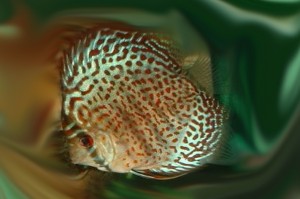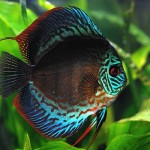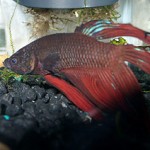Pairing and spawning
The least expensive way of obtaining a pair is probably to purchase a group of really young (50 cent sized) or juvenile (tennis ball sized) Discus and let them grow up together. As they reach adulthood, hopefully at least one pair will form in your group. Ideally provide your fish with a few suitable spawning sites to choose among, e.g. a flowerpot, a piece of slate and a broad leafed plant. Discus are however capable of using the aquarium glass as spawning site as well.
You can notice that a pair is about to be established when two specimens start to swim away from the rest of the group and feed together. With a little luck, you will soon see them guarding a part of the aquarium and cleaning a spawning site. After a while, they will be doing practice passes oven the spawning site and it is then only a matter of time before the actual spawning takes place.
During spawning, the female Discus will lay a small amount off eggs in a neat row and the male will follow behind her to fertilize them. She will then start with a new row; the male will fertilize that one too, and so on. The entire process can take up to an hour.
When all the eggs have deposited and fertilized, the pair will start taking turns at guarding the spawning site and fanning the eggs with fresh water. The eggs will normally hatch within two days and the parents will help the fry the get out of the shells and move them to a new location in the aquarium.
After another two days, the fry will start to become free swimming. The parents will be very busy catching any baby that swims away from the rest of the group – they will actually take the fry into their mouths and spit them back to their siblings. As more and more fry become free swimming, it will eventually become impossible for the parents to keep them put in one place. The fry will form a small school and start feeding from the sides of their parents. Sometimes Discus fry will starve to death since they do not find their parents in time when they have to feed.
Common problems associated with pairing
Some fish never wants to breed, not even when kept in superb conditions. Others do breed, but never manage to get as far as to free swimming fry. There are a few things you can to improve the chances of successful spawnings, but there are situations where nothing will help. Sometimes the aquarist simply has to realize that certain specimens will not breed and be content with keeping them as beautiful show specimens.
Infertility can be due to several different reasons, including genetic abnormalities. Overspawning, illness, medications and nutritional deficiencies can all lead to temporary infertility which can be cured by rest, suitable disease treatment, time, and a varied, nutritious diet. Permanent fertility is much more serious and can for instance be brought on by permanent damage caused by internal parasites or overuse of antibiotics.
It is actually quite common for two female Discus fish to form a pair, even if there are males present in the aquarium. This couple will act just like a heterosexual couple, i.e. feed together, guard a territory, clean a spawning site and go through the actual spawning motions. The problem is of course that no eggs will get fertilized. Some couples release their eggs simultaneously, while others take turns with one female laying eggs this week and the other one the next. The only way of breaking the bond between them is to split them up and introduce them to males.
A fighting couple that fails to get along is another problem that can prevent successful spawnings. Sometimes the fighting is fairly mild and you can safely leave them to try and sort out their problems on their own, but there are also situations where you must be ready to separate them to prevent serious injury. Try reintroducing them to each other after a few days and hope for things to go more smoothly then. Letting them stay with each other and cause injury just because you do not want to scarify a batch of eggs is not a good idea, because a fighting couple will normally end up loosing their offspring anyway.
Raising Discus fry
During the first few days, Discus fry will only feed from their parents and the only thing you can do is to keep the parents well-fed and carry out water changes to keep the water quality up. When the fry is around 4-5 days of age, you can start giving them newly hatched brine shrimp. Start with really small amounts of food to prevent the water from going foul. The fry will continue to feed from the side of their parents for at least 2-3 weeks and the brine shrimp is therefore only a supplement.
The longer you let the fry stay with their parents, the higher is the risk of internal parasites being transferred from adult fish to the offspring. Most breeders will therefore not let the fry feed from their parents as long as they would in nature. Roughly 7-10 days after becoming free swimming, Discus fry are normally developed enough to survive without their parents in a separate fry rearing tank.
Feed your fry newly hatched brine shrimp and supplement with microworms once in a while to make the diet more varied. As their mouths grow bigger, they will be able to swallow daphnia, small mosquito larvae and other similar foods. Do not introduce flake food until they are at least 4 weeks of age. Getting them to accept flake food normally takes a while. When your Discus fry have grown to be roughly the size of a 10 cent coin, they are big enough to eat grated frozen beef heart. Start out with only one serving a day and eventually increase it to several feedings per day. When your fish has been trained to accept flake food, beef heart and frozen blood worms, it is time to start weaning them off brine shrimp.
Discus Diseases
Just like any other fish, Discus fish can develop a rich profusion of different health problems. In this article, I will mention some of the most commonly occurring ones. By identifying health problems at an early stage, you will increase your chances of treating your Discus back to recovery. The best way of reducing the risk of disease is to keep your fish in its recommended environment (right temperature, correct water chemistry, low amounts of nitrogenous waste, avoid rapid change, etc) and provide it with a varied diet.
Hole in the Head
Hole in the Head is quite a common disease in certain big cichlids, including the Discus fishes. Early treatment is very important since it becomes harder to cure the longer you allow it to progress – it can even be fatal. Even if the fish manages to heal after the treatment, the wound can leave permanent scaring. Treating the wound when it is small is therefore strongly recommended. One of the most commonly used methods of curing Hole in the Head disease in Discus is to increase the water temperature from 30 degrees C to 36 degrees C over a couple of days, and keep it at 36 C for 8-10 days. An increased water temperature must always be combined with increased aeration to keep the oxygen level up. Heat treatment can be combined with orally administered Metronidazole (sold under the brand name Flagyl) once every three days, especially for severe cases.
If you notice that the high water temperature is highly stressful for your Discus, you must lower it and seek other ways of curing the problem. You can for instance try using Metronidazole treatment only.
Gill fluke
Gill flukes are unfortunately a common problem for Discus fish and are especially dangerous for Discus fry. Gill flukes are external parasites that destroy the gills and causes heavy breathing and erratic swimming. The infested fish can also become spastic or completely paralyzed and sink down to the bottom. It can be cured using formalin, but preventing it is naturally preferably. Since adult fish becomes less affected by gill flukes, infested parents will often be healthy enough to spawn. When they offspring have grown to about the size of a 10 cent coin, gill flukes transmitted by the parents will turn into a serious problem. Gill flukes can be prevented by moving the fry to their own aquarium as soon as they are big enough to eat something else than secretions from their parents. It is also important not to crowd fry aquariums.
White Spot, Velvet and Costia
White Spot Disease (Ich), Velvet and Costia are not very common in Discus fish since the high water temperature in Discus aquariums creates an unfavorable environment for these malicious micro organisms. If your fish develops White Spot Disease, Velvet or Costia, the best course of action is to increase the water temperature to 34 degrees. Velvet is normally eradicated after 2-3 days of heat treatment and Costia will succumb within day four. White Spot Disease has to be treated for 10 days, since the Ich parasite that causes the white spots is susceptible to heat during its free-swimming life stage only.
Internal parasites
A Discus can harbor internal parasites without really being ill, but in some situations the parasites will start to grow exponentially and can then pose a serious threat to your fish. Common warning signs are emaciation and white feces. It can be hard to diagnose exactly which parasites that is responsible without performing an autopsy, but many different parasites are fortunately sensitive to Metronidazole (Flagyl) treatment. Increasing the water temperature and providing additional aeration is also recommended. If your Discus is still eating, you can prepare a solution of 200 ml water and 10 ml liquid Flagyl and soak its favorite food in it, e.g. live worms or larvae, for about one hour. Feed your Discus medicated food every 2-3 days for 10 days. If your Discus has stopped eating it is much harder to medicate it since you will have to force feed it using a syringe without the needle. Prepare a mixture of one part liquid Flagyl, two parts Liquid fry food and three parts water. The liquid fry food is there to prevent the fish from starving to death while you treat it. Add the mixture to a syringe and place your Discus on a wet towel. Use the syringe to force 2 ml down the fish’s throat and wait for it to swallow before you return it to the aquarium. It will expel a lot of the mixture through its mouth and gills, but at least a bit of it will be swallowed. You need to feed your fish the medication twice a day until it starts to recover. Being exposed to this type of treatment is naturally always highly stressful for a fish, especially one that is already weakened by parasites.

Bacterial infections
Bacterial infections are common in aquariums that are not well maintained, but they can happen in “perfect” aquariums as well if you are unlucky. It is naturally impossible to identify the bacterium without access to a laboratory, but fish stores normally sell medications known to attack a wide range of bacteria. You can for instance use Chloromycetin. Purchase it in powder form and use 1 teaspoon per 100 liters of water. Calculation the exact capacity of your aquarium is very important to avoid over dosing. In many cases, a significant improvement can be seen within 8 hours. Chloromycetin will dissipate after 12 hours and you may have to administer a second dose after two days to be on the safe side.

















Leave a Reply